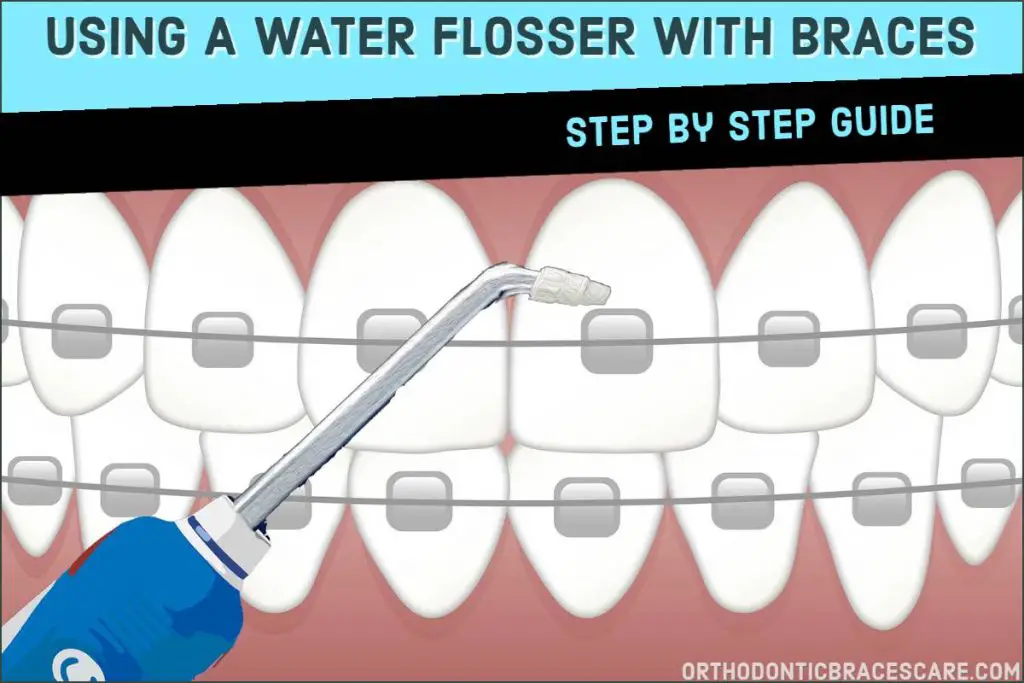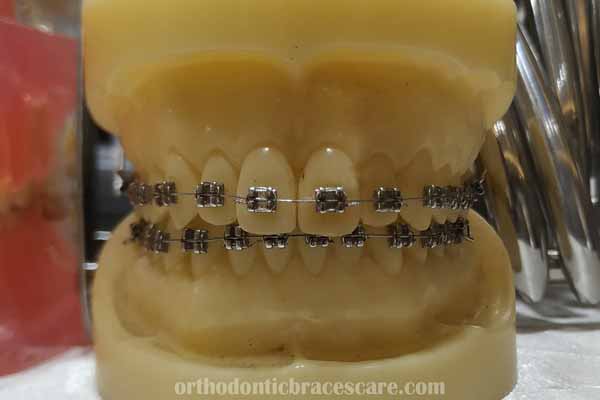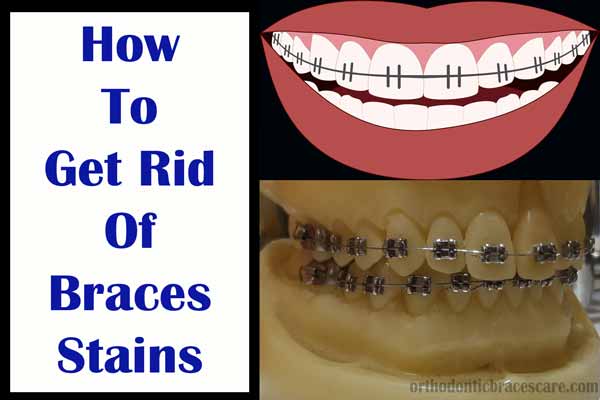Flossing is a mandatory task while wearing braces and now you get a special flosser like Waterpik flosser. So, you might want to know, Can you use a water flosser with braces?
You can use a water flosser safely and effectively with braces. In fact, water floss can make your job easy to clean teeth and braces thoroughly. It does this work by removing food debris and plaques from hard-to-reach areas of your teeth and braces.
But, How to use a water flosser with braces?
Using a Waterpik flosser with braces is a little bit different. You have to use an orthodontic tip to clean braces AND teeth. If you can use this oral irrigator appropriately, you get rid of plaque and food particles from your teeth and braces effectively. To do that, you need to follow some simple steps.
In this article, we’ll provide a beginner guide with steps to use a water flosser with braces. Let’s start.
Step-by-step guide to using a water flosser with braces

Here are the steps that you should follow to use a Waterpik or oral irrigator.
Step 1: Setting up the Waterpik device
1. Fill the water reservoir.
The device contains a water reservoir. You have to pour water on it. Remove the top part of the reservoir and use lukewarm water to fill it.
Lukewarm water helps soften the gums and makes it easier to loosen the food debris and plaque. Some people think of using saltwater.
But, never do that because it can block the pipe. Besides, don’t use too hot water, or it can be uncomfortable for you.
You can fill half the reservoir with fluoride or chlorhexidine mouthwash twice a week to get extra protection against bacteria.
2. Place the reservoir on the base.
After you fill the reservoir, place it gently on the base of the device.
3. Pick the right flosser tip.
You get different types of variety of flosser tips with Waterpik. You have to select the tip that’s perfect for your teeth.
Use the orthodontic tip for braces, as it’s specially made for braces wearers. Orthodontic Tip has a tapered brush that helps remove plaque and food particles from between teeth and braces.
You can reach those hard-to-reach areas of braces such as under the wires or around the brackets with the tip. If you don’t have it in your package, get a water flosser orthodontic tip for braces.
You can also use Classic Jet Tip with braces. This tip maintains a steady flow and cleans particles from the gums and teeth effectively.
If you don’t have it in your package, get a Classic Jet Tip. Other available tips are the toothbrush tip, the plaque seeker tip, the orthodontic tip, and the Pik pocket tip.
People with gum disease can use a Pik pocket tip and a plaque seeker tip is helpful for people having a crown, bridge, or implant.
4. Insert the flosser tip into the handle.
After picking the right tips, you have to place them on the handle and lock it into place. Check the manual guide to know how it can be fixed with the device. You can do it by pressing a button on the handle or twisting the tip.
5. Adjust the pressure setting and check the device.
You can control the water pressure or the flow with the pressure settings. Before inserting the flosser into the mouth, you have to turn the device on to check if it’s working perfectly.
For the trial, point the flosser tip into the sink and turn on the Waterpik. Check it with low to high-pressure settings.
If water flows nicely during the testing phase, turn the device off and proceed to the next step to clean your teeth and braces.
Step 2: Cleaning with the Waterpik
1. Set the pressure control.
When you insert the flosser into your mouth for the first time, you should start with low pressure.
2. Place the flosser tip in the mouth
Hold the handle of the Waterpik gently and place the tip into your mouth. Don’t turn the switch on now.
You have to start the cleaning from the back teeth. Hold the flosser tip away from the teeth, gums, and braces. Don’t touch or press them with the tip.
Start with either the outer or inner side of the teeth. You must spray the water in between teeth and under the brackets where a regular brush may not reach.
Take help from a mirror to place the tip perfectly. Don’t turn the switch on now.
3. Lean over the sink.
Lean your head a little bit forward above the sink before you start to clean your teeth and braces.
If you don’t do that, water will spread around. This will spill the water onto your clothes and make the process messy.
4. Turn on the device.
Now, turn on the unit to start cleaning your teeth and braces. Let the water flow from mouth to sink. Close your lips to prevent water splashback.
You can increase the water pressure if you feel it’s necessary or if you are comfortable with it.
5. Clean teeth, gum line, and braces correctly.
Aim the flosser tip in every tooth and braces one by one to remove food debris and plaque. Take two seconds to clean each tooth and bracket.
It’s better to start from the back and top teeth as plaque and food particles push forward from the flow of water.
Do the following technique while cleaning a tooth and braces.
First, point the flosser tip toward the gum line.
Then, aim the tip at the space between teeth.
Next, place the water flosser on the brackets and under the wires and brush the areas gently with a tapered brush of the orthodontic tip. Brush the teeth as well with it.
After that pull it away from the area to apply the stream of water to wash away the debris.
Complete cleaning teeth of both jaws from the back to the front one by one. The whole procedure may last for two minutes. However, don’t rush. Take more time if it’s necessary.
Step 3: Finishing
1. Turn the unit off.
When you are done, turn off the device. You can also remove the tip if you want. Use the same button or technique that you used to place it with the handle.
2. Empty the water reservoir.
Bacteria may grow inside it if some water remains in the water tank. You shouldn’t allow that as you are using it to clean your mouth.
So, empty the water reservoir. After that, check it carefully and make sure there is no water in the reservoir.
3. Clean the orthodontic tip properly.
You should clean the flosser tip nicely. It’s better to remove it from the handle. This allows the tip to get dry and prevents forming bacteria around it.
4. Keep Waterpik safe.
After everything is done, keep the Waterpik in a safe place.
5. Tips to use water floss with braces.
Here are a few tips you can follow while using Waterpik with braces:
- You can floss your teeth and braces with conventional or string flossers before using the Waterpik. Waterpik may not always remove all plaque effectively. In those cases, regular floss can be helpful as it uses its scraping action and loosens the plaque. After that, you can use the water flosser for final cleaning to remove the remaining debris and plaque.
- Start cleaning from the back teeth and finish at the front to get the best result.
- Don’t forget to clean the gum line. Many people forget it or aren’t even aware of it. But, it’s the area where plaque gets deposited and causes gum diseases.
- The beginner should place the flosser tip inside the mouth at first and then turn the unit on to prevent water from spraying out and get messy.
- Replace the flosser tip every 3 months as it starts to wear and tear after some days. The orthodontic tip has a tapered brush on it. Just like a regular toothbrush, you must replace it. Otherwise, it won’t work perfectly to remove food particles and plaque.
- Don’t forget to empty the water reservoir to prevent the production of bacteria.
- Clean the orthodontic tip with water nicely and make it dry after use to prevent plaque build-up.
- You can also buy the accessories or replacement parts after getting the Waterpik from the online store.
- Some parts are essential, if you buy it early and keep it, there is no problem. Especially you can get the flosser or orthodontic tip as you must replace it after a few months.
- Some parts are more likely to break. Don’t panic. You can get the part online and replace it.
- You should read the instruction manual as well with these steps. If you have lost it, you can download it from the website of your product’s brand.
When do you have to use a Waterpik flosser?
Use a Waterpik flosser at least once a day with braces on your teeth. It’s better to floss your teeth and braces after dinner to get the best result. After flossing, brush your teeth thoroughly with fluoride toothpaste.
Why should you use a Waterpik?
Waterpik is a special type of flosser that uses steam or water to clean your teeth and braces. You should use this to get into hard-to-reach areas of your teeth and braces.
Braces create so many rough and irregular surfaces in your mouth. So, you need extra effort to clean those areas.
You have to floss at least once a day along with brushing your teeth 2-3 times a day. But, at the same time, you need to be careful so that cleaning devices or methods can’t hurt your braces.
Waterpik can help you solve these problems. Most importantly, it can remove food particles and plaques effectively. Besides, the oral irrigator is easier to use and speeds up the work as well.
Frequently asked questions
How to wash the water reservoir?
Put a few teaspoons of chlorhexidine mouthwash or vinegar in the water reservoir or tank. Without placing the flosser tip, turn the device on, and drain the tank. This will clean the reservoir completely
How to fix water pressure?
Sometimes, the pressure of the water may get reduced due to many causes. Check all the parts carefully before replacing it. In most cases, you can fix it.
Ensure your electric output is functioning. Charge the device or replace the battery if it’s necessary (depending on the type of device). You also need to fill at least half the tank with water to get the high water pressure.
Check carefully if the black valve in the water reservoir is placed correctly in which the four-pronged side faces down and the dome side faces up.
To prevent any blockage or reduce pressure, don’t use saltwater. Try to clean the water reserver regularly with chlorhexidine mouthwash or vinegar. Besides, empty the reservoir completely after use.
How to fix a leaking Waterpik?
Leaking a Waterpik reservoir is a common problem that you can fix at home without replacing it.
There is a black rubber valve on the bottom of the water tank.
Remove the valve from pulling it out. Hold the valve under warm running water and keep massaging it with fingers.
After that insert the valve into the reservoir again where the four-pronged side faces down and the dome side faces up.
Takeaways
Using a Waterpik is very easy and you have less chance of getting hit by it to braces. Moreover, you can clean your teeth and braces effectively and improve oral health if you use them in the right way.
Pallab Kishore is a certified dentist and the owner of Orthodontic Braces Care.
He completed BDS in 2014. Now, he is an MS resident in Orthodontics, BSMMU. He likes content writing and has 12+ years of experience in blogging.


